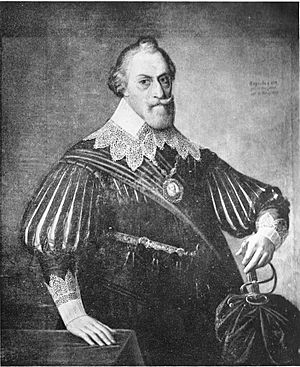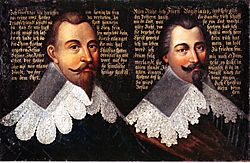Bogislaw XIV, Duke of Pomerania facts for kids
Quick facts for kids
Bogislaw XIV
|
|
|---|---|
 |
|
| Duke of Pomerania | |
| Reign | 6 February 1625 – 10 March 1637 |
| Predecessor | Barnim IX |
| Successor | Christina (as personal union) |
| Born | 31 March 1580 Barth |
| Died | 10 March 1637 (aged 56) Stettin |
| Noble family | House of Griffins |
| Spouse(s) | Elisabeth of Schleswig-Holstein-Sonderburg |
| Father | Bogislaw XIII, Duke of Pomerania |
| Mother | Clara of Brunswick-Lüneburg |
Bogislaw XIV (born March 31, 1580 – died March 10, 1637) was a very important ruler in a place called Pomerania. He was the very last Duke of Pomerania, which means he was the main leader of this area. He also served as a Lutheran administrator for the Prince-Bishopric of Cammin, which was a church-led territory.
Contents
Early Life and Becoming a Duke
Bogislaw was born in a town called Barth. He was part of a powerful family known as the House of Pomerania. His father was Duke Bogislaw XIII. When his father passed away in 1606, Bogislaw and his younger brother, George II, became joint dukes of Rügenwalde (now called Darłowo).
After his brother George II died in 1617, Bogislaw became the sole ruler of Rügenwalde. In 1620, his lands became part of the Duchy of Stettin. He inherited this larger area when his older brother, Francis, passed away. By early 1625, Bogislaw became the ruler of all West Pomerania. This happened after the last Duke of Wolgast, Philipp Julius, died.
On February 19, 1625, Bogislaw married Elisabeth. She was born on September 24, 1580, and passed away on December 21, 1653. Elisabeth was the fifth daughter of John II, Duke of Schleswig-Holstein-Sonderburg.
Pomerania During the Thirty Years' War
Bogislaw tried very hard to keep Pomerania out of the Thirty Years' War. This was a huge and terrible war that affected much of Europe. However, his efforts did not succeed. In 1627, he was forced to sign an agreement called the Capitulation of Franzburg. This agreement made him allow imperial troops, led by Albrecht von Wallenstein, to use his lands. They used Pomerania as a base for their military operations.
Because of this, Pomerania became deeply involved in the war. This brought many terrible problems and consequences to the region. In the 1630s, many local nobles tried to reduce Bogislaw's power. Dealing with these challenges was very stressful for him. It even caused him to have a stroke, which left him partly paralyzed.
In 1634, Bogislaw gave up his role as duke. This is called abdicating. There was no clear person to take his place. This led to a big power struggle among his relatives and the governing council. At this time, most of Pomerania was taken over by Swedish and imperial armies.
The End of Pomerania's Independence
Bogislaw passed away in 1637. Because of all the arguments about who should rule next and the future of Pomerania, his body was not buried for nearly 20 years! This shows how complicated and serious the situation was.
Two main groups wanted to take over Pomerania. One was George William, Elector of Brandenburg. His family had an old agreement from 1464 to inherit Pomerania. The other was Bogislaw's brother-in-law, Gustavus Adolphus, who was the King of Sweden. Sweden had already taken control of much of Pomerania when they joined the Thirty Years' War in 1629.
Bogislaw's last will stated that if his family line ended, his lands should go to Sweden, not to Brandenburg-Prussia. Both Sweden and Brandenburg used their military power to push their claims. They also took advantage of the disagreements within Bogislaw's own family.
Finally, the war ended with the Peace of Westphalia in 1648. At this peace treaty, Pomerania was divided. Its lands were split between Sweden and Brandenburg. This meant that Pomerania stopped being an independent political area.
On May 25, 1654, Bogislaw's body was finally laid to rest in Stettin. This was almost seven years after Pomerania lost its independence. It happened only after his wife, Elisabeth of Schleswig-Holstein-Sonderburg, had also passed away.
See also
In Spanish: Bogislao XIV de Pomerania para niños


